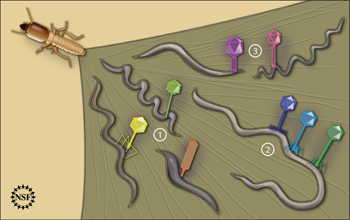Multimedia Gallery
Virus-bacterium associations were examined in the natural environment of a termite's hindgut.
Virus-bacterium associations were examined in the natural environment of a termite's hindgut. Three general scenarios were seen. In the first (1) there was a one-to-one association: one type of virus matched one type of bacterium host. In the second (2) the host bacterium was associated with a diverse group of viruses, indicating perhaps a more ancient infection or a more susceptible host. In the third case (3) very similar viruses were seen infecting several different types of bacterial hosts.
This study tested methods of examining virus-bacterium interactions in nature, rather than in vitro--from a culture. It opens a new door to understanding the diverse and highly populated world of viruses and bacteria that we know so little about.
Credit: Zina Deretsky, National Science Foundation
Images credited to the National Science Foundation, a federal agency, are in the public domain. The images were created by employees of the United States Government as part of their official duties or prepared by contractors as "works for hire" for NSF. You may freely use NSF-credited images and, at your discretion, credit NSF with a "Courtesy: National Science Foundation" notation.
Additional information about general usage can be found in Conditions.
Also Available:
Download the high-resolution JPG version of the image. (375 KB)
Use your mouse to right-click (Mac users may need to Ctrl-click) the link above and choose the option that will save the file or target to your computer.
Related story: When Viruses Infect Bacteria



